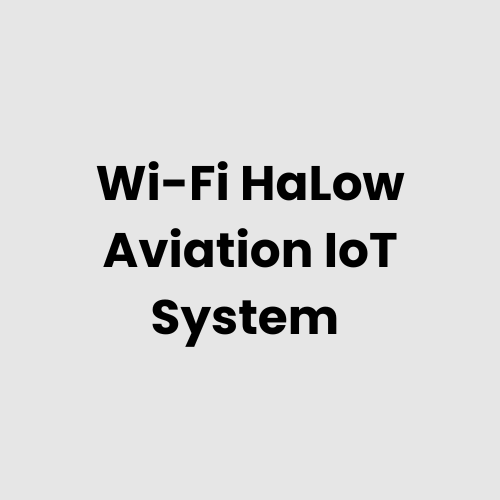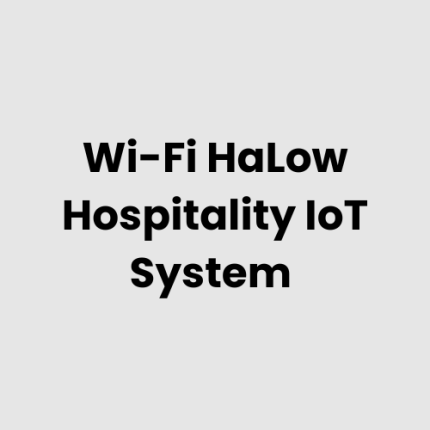Description
Wi-Fi HaLow Enabled Aviation IoT System: Technical Architecture
The Wi-Fi HaLow Enabled Aviation IoT System leverages the capabilities of Wi-Fi HaLow (IEEE 802.11ah) technology to create a robust, scalable, and low-power communication infrastructure for the aviation industry. This system is designed to enhance operational efficiency, safety, and passenger experience within airports, aircraft, and related facilities by enabling real-time data exchange across a wide array of IoT devices.
The technical architecture of the system is built on several layers to ensure high performance and low latency:
- Connectivity Layer: The Wi-Fi HaLow communication protocol is the backbone of the system, offering long-range connectivity with lower power consumption. This makes it ideal for large airport facilities and aircraft, where traditional Wi-Fi or cellular connectivity may not be as effective.
- Device and Sensor Layer: This includes a variety of sensors and devices deployed across the airport and aircraft, such as temperature, humidity, and pressure sensors, as well as more specialized equipment for asset tracking, passenger flow management, and safety monitoring.
- Edge Computing Layer: Data collected from IoT devices is processed at the edge, allowing for real-time decision-making and reduced latency. This is particularly important for critical tasks like baggage tracking, fleet management, and environmental monitoring in aircraft.
- Data Aggregation and Processing Layer: Data from multiple sources is aggregated and sent to centralized systems for analysis, enabling insights into operational efficiency, predictive maintenance, and passenger experience enhancements.
- Integration Layer: The system integrates seamlessly with existing airport management and airline operations systems, ensuring a cohesive environment that supports activities such as ticketing, baggage handling, and security protocols.
- Security Layer: Security is paramount in the aviation industry, and the system ensures encrypted communication, secure device authentication, and compliance with aviation data privacy regulations.
Hardware Components of the Wi-Fi HaLow Enabled Aviation IoT System
The hardware that supports the Wi-Fi HaLow Enabled Aviation IoT System is specifically designed to operate in challenging environments, such as airports and aircraft. The key components include:
- Wi-Fi HaLow Routers and Gateways: These devices form the core of the communication network, ensuring long-range, low-power connectivity across the large expanse of airport terminals and aircraft cabins.
- IoT Sensors: These include environmental sensors (temperature, humidity, pressure), asset tracking devices, motion detectors, and security cameras deployed throughout airports and on aircraft.
- Wearable Devices: Used for tracking staff or passengers in real-time, wearable devices also provide location-based services and notifications, enhancing operational management.
- Edge Computing Devices: These localized processors handle data near the source, enabling real-time decision-making and reducing the need for large-scale data transmission.
- Monitoring and Control Stations: Centralized control stations are used for managing the network, analyzing data, and overseeing operations in the airport and aircraft.
- RFID and Barcode Scanners: These devices assist in baggage handling, asset tracking, and managing inventory, ensuring a smooth operational flow.
- Power Solutions: Efficient power solutions, including battery-powered devices and energy-efficient systems, ensure that IoT devices continue to operate reliably across airport premises and within aircraft.
Physical Placement Considerations of the Hardware
Strategically placing the hardware components is essential for optimizing the performance of the Wi-Fi HaLow Enabled Aviation IoT System. The following placement considerations ensure maximum effectiveness:
- Router and Gateway Placement: Wi-Fi HaLow routers and gateways should be installed in key areas like terminals, runways, gates, and hangars to ensure comprehensive network coverage, even in remote or difficult-to-reach areas. The long-range capability of Wi-Fi HaLow ensures reliable communication in large airport environments.
- Sensor Placement: Sensors should be strategically placed in high-traffic areas (e.g., baggage claim, check-in counters, and security checkpoints) and on critical systems (e.g., HVAC units, aircraft engines, cargo bays) to monitor operational conditions and assets in real time.
- Wearable Device Placement: Staff and operational teams can wear IoT devices for tracking purposes. In airports, wearables can be distributed among staff members for improved coordination, while passengers may be issued devices to track their baggage and receive notifications.
- Edge Device Placement: Edge devices should be positioned near critical operational systems, such as baggage handling units, security systems, and aircraft maintenance equipment, to enable rapid processing of data and reduce reliance on cloud-based systems for time-sensitive tasks.
- Security Cameras and Asset Tags: These devices should be positioned in key locations to monitor the flow of passengers and assets, and to provide real-time security surveillance.
Hardware Architecture of the Wi-Fi HaLow Enabled Aviation IoT System
The system’s hardware architecture consists of a highly integrated network of devices and infrastructure components that work together to enable real-time data collection, analysis, and decision-making:
- Core Communication Network: Wi-Fi HaLow routers and gateways establish the long-range communication network across the airport, providing seamless connectivity to IoT devices, sensors, and wearable equipment.
- IoT Devices: These include sensors (environmental, security, and asset tracking) and other devices that are deployed throughout the airport or on aircraft to gather data on operational conditions, asset status, and passenger movement.
- Edge Computing Devices: These devices process data locally at the point of collection, reducing latency and enabling faster decision-making for operations like baggage tracking, security alerts, and maintenance scheduling.
- Centralized Data Systems: The system aggregates and processes the collected data on centralized servers or cloud platforms, offering predictive maintenance, resource optimization, and insights for better operational management.
- Integration with External Systems: The system is designed to integrate with existing aviation management systems, such as security, ticketing, and baggage handling, providing a unified platform for managing all aspects of airport and airline operations.
Deployment Considerations of the Wi-Fi HaLow Enabled Aviation IoT System
Effective deployment of the Wi-Fi HaLow Enabled Aviation IoT System requires careful planning to ensure seamless integration and operational success:
- Site Survey and Planning: Conducting a comprehensive site survey is crucial for identifying the best placement for routers, sensors, and other hardware, ensuring maximum coverage and network reliability across the airport or aircraft.
- Scalability: The system should be designed to scale as needed, especially for expanding airports or evolving operational needs. It should be flexible enough to accommodate additional devices or upgrades without disrupting existing operations.
- Integration with Legacy Systems: The IoT system should be able to integrate with legacy airport and airline systems for ticketing, baggage handling, and security, ensuring a cohesive and efficient operational flow.
- Security Compliance: All components of the system must adhere to industry security standards to protect sensitive data and comply with aviation regulations.
- Sustainable Energy Solutions: Power management is crucial in remote areas such as runways or aircraft. Deploying energy-efficient devices or integrating solar-powered sensors can help reduce energy consumption.
- Training and Support: GAO Tek provides specialized training and support for your operational staff, ensuring smooth deployment and optimal use of the system. Our expert team is available for both remote and on-site assistance.
List of Relevant Industry Standards and Regulations
- IEEE 802.11ah (Wi-Fi HaLow Standard)
- International Air Transport Association (IATA) Standards
- International Civil Aviation Organization (ICAO) Guidelines
- FAA (Federal Aviation Administration) Regulations
- ISO 27001 (Information Security Management)
- General Data Protection Regulation (GDPR)
- National Institute of Standards and Technology (NIST) Cybersecurity Framework
- Environmental Protection Agency (EPA) Standards
- Occupational Safety and Health Administration (OSHA) Regulations
- ISO 9001 (Quality Management Systems)
Local Server Version: Running with a Local Server
For organizations that prefer to manage operations on-site, the Wi-Fi HaLow Enabled Aviation IoT System can be deployed with a local server setup.
- Local Data Processing: Data from IoT devices, sensors, and edge computing devices is processed locally to provide real-time insights and decision-making, critical for tasks like maintenance and safety monitoring.
- Data Security: On-premise data storage ensures that sensitive information remains within the organization’s control, offering enhanced privacy and compliance with data protection regulations.
- Operational Efficiency: With local servers, the system can function even in remote locations of the airport, reducing dependency on external network connections and enhancing reliability.
Cloud Integration and Data Management
Cloud integration significantly enhances the capabilities of the Wi-Fi HaLow Enabled Aviation IoT System by providing scalable data storage, advanced analytics, and real-time reporting:
- Cloud Storage: Data collected from IoT devices is securely stored in the cloud, providing high availability, easy access, and protection against data loss.
- Advanced Analytics: The system can process large datasets in the cloud, providing predictive maintenance insights, operational forecasts, and optimizing resource management.
- Integration with External Systems: Cloud integration enables seamless data exchange with third-party systems, such as security and ticketing, creating a unified platform for airport and airline management.
- Real-time Access: Cloud-based systems allow operational managers to access real-time data from anywhere, providing immediate updates on flight status, baggage handling, and other critical operations.
GAO Tek Inc. is at the forefront of delivering advanced IoT systems for aviation, providing high-performance solutions that enhance operational efficiency and security. Our extensive expertise ensures that your airport or airline operation.
GAO Case Studies of Aviation IoT
USA Case Studies
- Atlanta, Georgia
An international airport in Atlanta deployed IoT-based baggage tracking systems, enabling real-time monitoring and reducing lost luggage incidents. GAO Tek’s IoT technologies ensure efficient and reliable logistics for aviation operations. Learn about baggage tracking IoT.
- Dallas, Texas
A major airport in Dallas used IoT-enabled predictive maintenance for ground vehicles, minimizing breakdowns and enhancing operational efficiency. GAO Tek provides robust IoT solutions for predictive maintenance. Discover IoT for ground operations.
- Chicago, Illinois
An airport in Chicago implemented IoT-driven energy management systems, optimizing power usage and reducing environmental impact. GAO Tek supports sustainable aviation through advanced energy IoT technologies. Explore energy optimization IoT.
- Denver, Colorado
A Denver airport integrated IoT systems to monitor runway conditions in real-time, improving safety during adverse weather. GAO Tek’s IoT solutions enhance operational safety in aviation. Learn about runway monitoring IoT.
- San Francisco, California
An airport in San Francisco deployed IoT-connected kiosks for seamless passenger check-ins and shorter wait times. GAO Tek offers innovative IoT solutions for enhanced passenger experiences. Discover IoT for check-in systems.
- Miami, Florida
Miami’s international airport implemented IoT-enabled air quality monitoring systems, ensuring passenger and staff comfort. GAO Tek’s IoT systems deliver precise environmental monitoring. Explore air quality IoT.
- Seattle, Washington
A Seattle airport used IoT technology for real-time aircraft parking management, improving operational efficiency. GAO Tek provides advanced IoT solutions for aircraft logistics. Discover IoT for aircraft parking.
- Orlando, Florida
A regional airport in Orlando integrated IoT-based smart lighting systems, reducing energy costs and enhancing visibility. GAO Tek’s smart lighting IoT solutions deliver efficiency and safety. Learn about smart lighting IoT.
- Phoenix, Arizona
An airport in Phoenix utilized IoT sensors for monitoring jet fuel levels, ensuring timely refueling and preventing delays. GAO Tek supports critical aviation operations with IoT-enabled monitoring. Discover IoT for fuel management.
- Houston, Texas
A Houston airport introduced IoT-based asset tracking for ground support equipment, improving resource allocation and reducing downtime. GAO Tek’s IoT technologies optimize asset utilization in aviation. Explore asset tracking IoT.
- Los Angeles, California
An airport in Los Angeles deployed IoT-enabled passenger flow monitoring, ensuring smoother operations during peak hours. GAO Tek offers solutions to enhance operational efficiency with real-time data. Discover passenger flow IoT.
- Boston, Massachusetts
A Boston airport implemented IoT-driven maintenance alerts for escalators and elevators, enhancing passenger convenience and safety. GAO Tek supports proactive maintenance solutions through IoT. Learn about maintenance IoT.
- Las Vegas, Nevada
An airport in Las Vegas integrated IoT systems for tracking VIP passenger services, ensuring premium service delivery. GAO Tek delivers personalized IoT solutions for customer satisfaction. Explore VIP tracking IoT.
- New York, New York
A New York airport used IoT-enabled noise monitoring systems to minimize community impact and comply with regulations. GAO Tek’s IoT solutions ensure compliance with environmental standards. Discover noise monitoring IoT.
- Charlotte, North Carolina
An airport in Charlotte deployed IoT-based cargo tracking, improving supply chain transparency and reducing losses. GAO Tek’s IoT technologies ensure seamless logistics for aviation cargo. Explore cargo tracking IoT.
Canada Case Studies
- Toronto, Ontario
Toronto’s Pearson Airport implemented IoT-enabled automated temperature control systems for cargo storage, maintaining product integrity. GAO Tek supports efficient cargo management with IoT technologies. Learn about cargo temperature IoT.
- Vancouver, British Columbia
Vancouver’s airport used IoT for real-time monitoring of de-icing operations, ensuring safe winter operations. GAO Tek’s IoT solutions enhance safety and efficiency in extreme conditions. Discover de-icing IoT solutions.
Navigation menu for Wi-Fi HaLow
- Wi-Fi HaLow Gateways/Routers
- Wi-Fi HaLow End Devices
- Wi-Fi Halow – Cloud, Server, PC & Mobile Systems
- Wi-Fi HaLow Accessories
Navigation Menu for IoT
- LORAWAN
- Wi-Fi HaLow
- Z-WAVE
- BLE & RFID
- NB-IOT
- CELLULAR IOT
- GPS IOT
- IOT SENSORS
- EDGE COMPUTING
- IOT SYSTEMS
Our products are in stock and can be shipped anywhere in the continental U.S. or Canada from our local warehouse. For any further information, please fill out this form or email us.
We are looking for partners. For more information on partnering with GAO, please visit Partner with GAO Tek Inc. It lists various ways to partner with GAO, such as OEM Partnerships, Technology Integration, Distribution and Reselling Opportunities, Presenting at the Leading Event TekSummit, Joint R&D Projects, Training and Consulting Services, Industry-Specific Collaborations, Research and Academic Partnerships.



